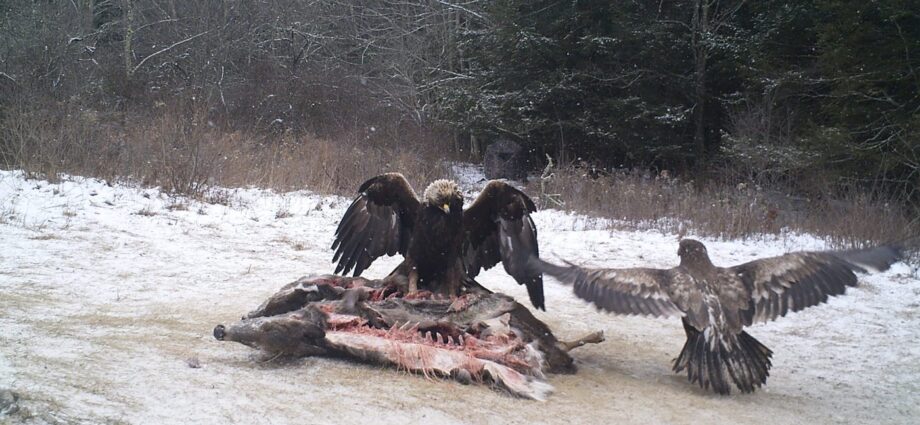
By Jeff Pelletier, Local Journalism Initiative Reporter, Nunatsiaq News
January 18, 2023
You’d have to be an Air Inuit frequent flier to cover the route that Marie, a 10-year-old golden eagle, flew last summer.
The raptor was tracked flying clockwise around the entire region of Nunavik last year not once, but twice.
Tom Salo, a member of the Delaware-Otsego Audubon Society in New York, has been collecting data on Marie since 2016.
She was trapped and fitted that year with a solar-powered tracking device, which provided time and location information as she flew around Quebec and the northeastern United States.
Golden eagles are not an endangered species, but like other birds of prey such as bald eagles and osprey, they have experienced a population drop and rebound due to a variety of human activities such as the use of powerful insecticides and the construction of wind turbines.
Their population in eastern North America is estimated at around 5,000, which is less than half of the species’ population on the west coast.

“The eastern population is a small population,” Salo said.
“The concern isn’t so much that these birds are in trouble, but that the buildout of wind power that is coming could threaten them.”
Collecting location data on golden eagles could help inform experts on where the birds tend to congregate. But in the case of Marie, it could tell one individual raptor’s story.
Marie is a wanderer, according to Salo.
While many golden eagles spend their summers in a specific territory, looking for a mate to reproduce for an extended period, Marie has been quite nomadic over the past few years.
“She hasn’t nested, but she’s looking for a territory; she’s looking for a mate,” he said.
![Sony PlayStation Store 110 - Sony, [Digital]](https://i0.wp.com/i5.walmartimages.com/asr/5d3e8d52-3525-4e75-b862-10394c67a31c.c3f21de9f6a2f65537248191772f43b3.png?w=1380&ssl=1)
Marie’s spring and summer 2022 flight path, visualized on a Google Earth map of Nunavik. (Image courtesy of Tom Salo/Delaware-Otsego Audubon Society)
Marie spent winter of last year in her usual spot around eastern New York and Pennsylvania, then flew north towards Kuujjuaraapik on Hudson Bay in March.
At the end of the month, Marie flew from Akulivik along the length of the Hudson Strait and was pinged in Quaqtaq in late April. Shortly after, she flew over Tasiujaq and Kuujjuaq, and by May, she was out of the region.
At the end of May, however, she began retracing her steps – or perhaps the flaps of her wings – before spending much of July and August flying between Ivujivik and Salluit in the northernmost parts of Nunavik.
It’s hard to tell what Marie was up to there, but Salo said it’s possible she was scavenging hunters’ leftovers or other dead animals in the area. According to observations Salo has made while tracking this bird, Marie has frequently been spotted by wildlife cameras eating dead animals close to populated areas rather than hunting live prey.
“We know she’s a scavenger, and I don’t know what you find on the shore there, but if there’s dead stuff washing up, I’m sure she’d be inclined to eat some of it,” Salo said.
“She intensely hangs around the shore there.”
After the summer, Marie returned to her regular winter range in the Catskill Mountains in New York.
Salo said that he’s not sure if Marie’s flight path is unique, as he has limited data to work with.
“I think there’s a lot more golden eagles up there,” he said.
But the thing he finds most interesting about this bird is her tendency to not be afraid of people. Over the years, Mary has been spotted along roads eating hunters’ bait and roadkill.
Subscribe to our newsletter.
“This bird would just feed along the highway,” Salo said.
“Maybe she’s a little bit less sensitive to disturbances by people than the average golden eagle.

